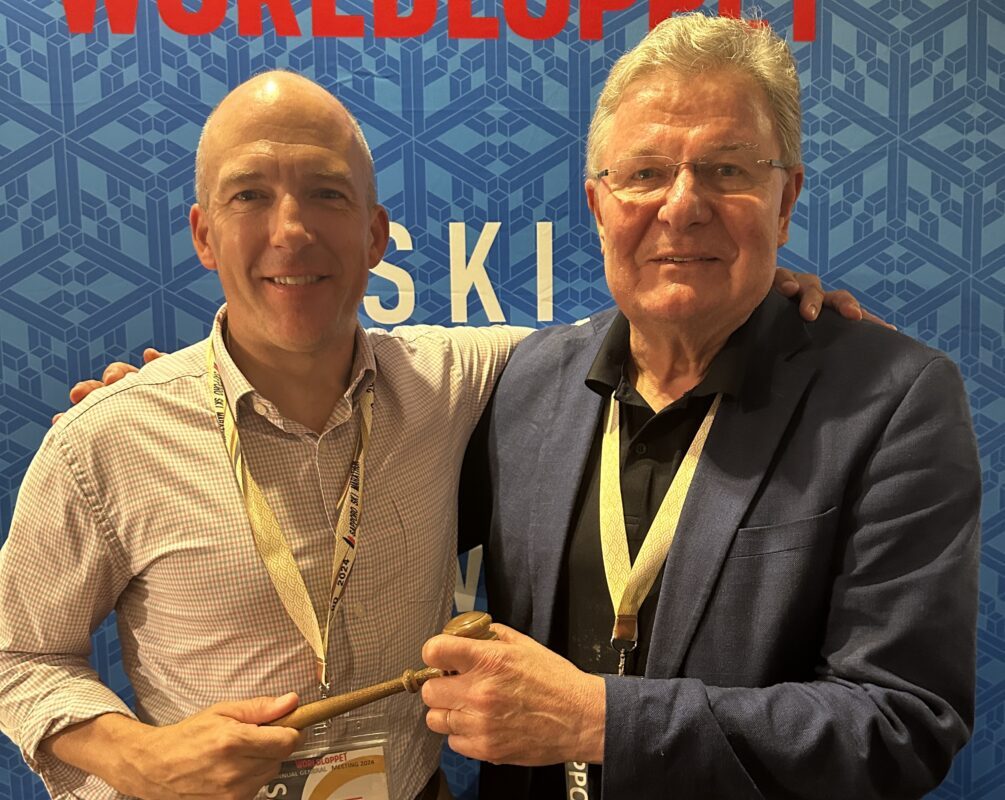
LAKE PLACID, N.Y. – Rollerskiing through thick fog on a sleepy Thursday morning, several U.S. Ski Team and National Training Group athletes wheeled into the Olympic Jumping Complex parking lot.
Almost an hour before their 9 a.m. sprint workout, the small group arrived earlier than some of the venue’s staff, but they weren’t the first athletes there.
As they pulled up alongside a row of parked vehicles, a few skiers recognized one another, and without tipping their sunglasses to be sure, they smiled.
For some, it had been months since they last crossed paths. Others, like Dartmouth skiers Sophie Caldwell and Sam Tarling, were happy to see college teammates.
The second day of the USST 1 ½-week dryland camp in Lake Placid garnered enthusiasm and interest. A few collegiate racers, including Middlebury’s Doug Debold and Chase Marston, came out specifically for the morning session: a classic sprint time trial.
“For a lot of us, we’re separated all over the country,” said Sylvan Ellefson of Team HomeGrown in Vail, Colo. “For me, I’m coming from altitude so it’s good for me to come down here and mix it up with these faster guys.”
A small group of nine men made it to Thursday’s workout, where USST members Kris Freeman and Noah Hoffman pushed the pace. (A few other top skiers stayed at the Olympic Training Center to rest and recover: Andy Newell was sick, Simi Hamilton had a knee injury and Skyler Davis left the workout because of illness.)
Back at the ski jumps, six women, including Liz Stephen and Ida Sargent of the USST, participated in the two-hour, four-heat workout. Men raced a 1.5-kilometer loop and women repeated the 1.3-k distance over hilly terrain. Everyone advanced, and athletes measured their lactate threshold and heart rates after first and last heats.
At the end of the session, which was intensified by warming temperatures with the fog-burning sun, many athletes agreed: that was hard.
“You’re going head to head,” USST B-Team member Tad Elliott said. “So you get a little competitive edge going, that makes you go harder too. It is fun, maybe a little scary on the downhills.”
Elliott finished third in the final in 3:32, one second behind Hoffman and two behind Freeman. He reached a lactate level of about 11.2, which Elliott said was a personal high.
Freeman said the test is “basically a measure of how much pain you’re in.” For him, it was 12.1. Hoffman, whose reading of 14.1 doubled that of one his treadmill workouts, said it indicated that his intensity training was working.
“It means I can really dig deep, and it means I’m starting to come into race form,” Hoffman said.
Ida Sargent was consistently the top finisher on the female side, with a time of 3:42 in the final. She and Stephen said it was beneficial to mimic the time trial setting, even in small group.
“You can’t do this by yourself to the same level,” Stephen said. “Of course, you put a bunch of competitive skiers together and somewhere in you’re mind, it’s like, ‘I want to beat them.’ Which is why you get faster, right?”
The group will race again on Monday in a longer prologue format (3.75 and 2.5 k) that requires pacing and endurance. Several top juniors were expected to join the camp starting Sept. 10 and train throughout the week. Per usual the camp will end with the grueling Climb to the Castle rollerski race, a 5-mile freestyle grind up Whiteface Mountain.
On Oct. 1, the USST will wrap up its dryland training with an altitude camp in Park City, Utah. Head coach Chris Grover said he chose to move up the Lake Placid camp, held in October last year, to give athletes a chance for some intensity training at Lake Placid’s relatively lower elevation (about 2,000 feet).
“We have a group of athletes coming from the west, from altitude, so their focus is really being able to go hard and to be able to recover faster,” Grover said. “For the athletes that are from the east, it’s more of a chance to also focus on the intensity sessions, but from the perspective that, I’m going to get in there and mix it up with some fast athletes and get a chance to knock heads a little bit.”
Classic Sprint Time Trial Results
Women’s Final
1. Ida Sargent 3:42
2. Sophie Caldwell 3:45
3. Liz Stephen 3:47
4. Corey Stock 3:56
5. Isabell Caldwell 4:04
6. Anne Hart 4:10
Men’s Final
1. Kris Freeman 3:30
2. Noah Hoffman 3:31
3. Tad Elliott 3:32
4. Matt Briggs 3:34
5. Sylvan Ellefson 3:35
6. Sam Tarlin 3:51
7. Chase Marston 3:52
8. David Sinclair 3:53
9. Doug Debold 3:54
Alex Kochon
Alex Kochon (alexkochon@gmail.com) is a former FasterSkier editor and roving reporter who never really lost touch with the nordic scene. A freelance writer, editor, and outdoor-loving mom of two, she lives in northeastern New York and enjoys adventuring in the Adirondacks. She shares her passion for sports and recreation as the co-founder of "Ride On! Mountain Bike Trail Guide" and a sales and content contributor at Curated.com. When she's not skiing or chasing her kids around, Alex assists authors as a production and marketing coordinator for iPub Global Connection.



